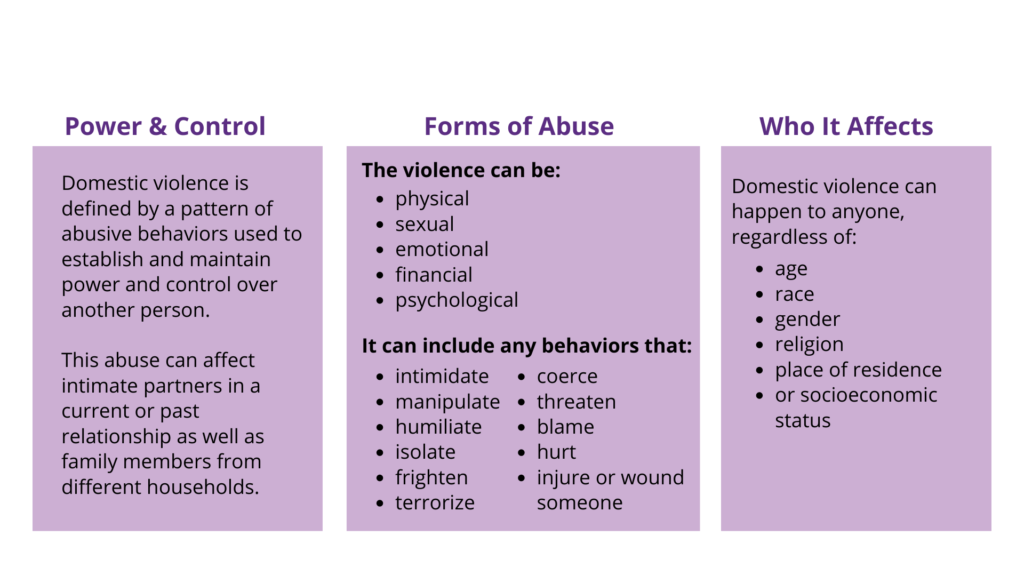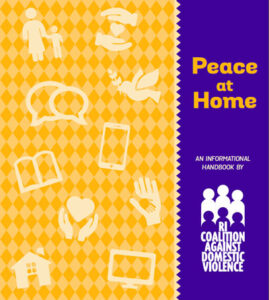What is Abuse?
Am I Experiencing Abuse?
Services to
Support You
Legal Protections and Resources
What is Domestic Violence?
Domestic violence is defined by a pattern of abusive behaviors used to establish and maintain power and control over another person. This abuse can affect intimate partners in a current or past relationship as well as family members from different households.
The violence can be physical, sexual, emotional, financial, or psychological. It can include any behaviors that intimidate, manipulate, humiliate, isolate, frighten, terrorize, coerce, threaten, blame, hurt, injure, or wound someone.
Domestic violence can happen to anyone, regardless of age, race, gender, religion, place of residence, or socioeconomic status.

Power and Control
Domestic violence consists of a combination of abusive tactics and different sets of behaviors that an abusive partner uses to establish and maintain power and control.
An abuser may present any of these tactics and behaviors at any one time to enforce power within the relationship. Often, physical or extreme violence that is more overt reinforces routine, more subtle methods of abuse. That is why it is important for everyone to be informed about the warning signs of relationship violence.
The Power and Control Wheel can help you better understand the dynamics of abuse. It is a tool that can help survivors realize they are not alone in what they are experiencing and can help convey to bystanders the insidious nature of abuse, the complexities of domestic violence, the many forms it can take, and the difficulties and dangers that survivors face in ending their abusive relationship.
View the Power and Control Wheel (Domestic Abuse Intervention Programs, The Duluth Model).
Peace at Home
If you are looking for steps you can take to end an abusive relationship while staying safe, or looking to learn more about domestic violence so you can support a friend, this informational handbook can help guide you.
- Click here to access this resource in English.
- Click Her to access this resource in Spanish.
- To request a hard copy, please contact the RICADV at 401-467-9940 or email ricadv@ricadv.org.
Warning Signs
It is important to be able to identify warning signs of abuse.
Red flags of an abusive person include someone who:
- Wants to move very quickly into a relationship
- Does not respect boundaries
- Is excessively jealous and accuses their partner of having affairs
- Must know where their partner is at all times; frequently calls, emails and texts their partner to monitor them; forces their partner to check in at certain intervals throughout the day
- Criticizes or puts down their partner, particularly by telling them they are “crazy,” “stupid,” and/or undesirable or that no one would ever want or love them
- Says one thing and does another
- Takes no responsibility for their behavior and blames others
- Blames the failure of previous relationships on their past partners
- Grew up in an abusive or violent home
- Insists that their partner stop spending time with friends or family or that they withdraw from activities and hobbies
- Rages out of control and is impulsive
If you are being abused, know that you are not alone and that the abuse is not your fault.
If you are in an abusive relationship or think that you might be, you deserve safety and support. Call the statewide Helpline (1-800-494-8100) to speak with an advocate who can help or contact a local domestic violence agency. All calls and services are confidential.
Helpline Available 24/7
The confidential statewide Helpline can be reached by calling 1-800-494-8100 or using the online chat here. The Helpline is for all victims of violent crime, including domestic and dating abuse, and those looking for more information to help a victim of violence.
